Types of pots, nuances of choice and use
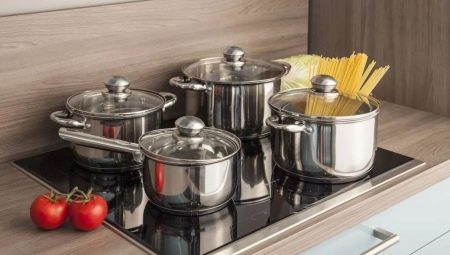
Today, a saucepan is one of the indispensable utensils for any kitchen. It is used for cooking, stewing and even frying food. This article will discuss the most popular types of pots, the nuances of their choice and use at home.
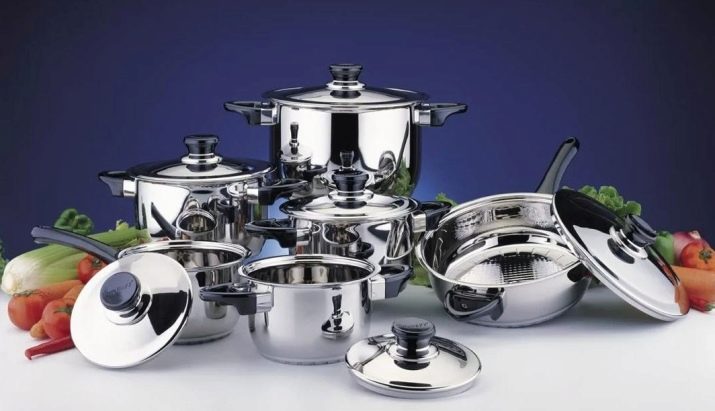
What it is?
A saucepan is a kind of container for cooking (boiling, frying and stewing) food. Unlike their predecessors (pots), pots usually have two handles and a removable and tight-fitting lid.

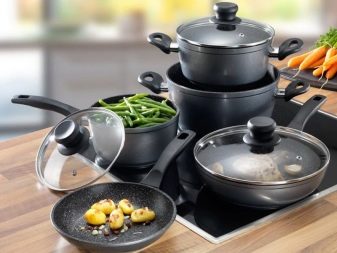


Views
Pots have long been an indispensable cooking tool in kitchens, and with the variety of shapes and methods of cooking, their variety has expanded. The most popular types of pots will be discussed below.
- Kazan. A common type of pots used for cooking pilaf and cereals. This option is thicker, but not square, but rather a semicircular shape. Thanks to this form, food can simply languish for a considerable time, while not overcooking or burning. For the manufacture of a cauldron, as a rule, it is cast iron that is used - only it can provide the required wall thickness.
The peculiarity of cooking in a cauldron is that here the temperature is equally distributed between the bottom and the walls themselves.


- Double boiler. The peculiarity of cooking in a double boiler is that the food does not have direct access to water or fire, but heats up exclusively thanks to the steam. Such food is considered very healthy, and vegetables cooked in a double boiler remain juicier and retain all the nutrients.If we consider the design of such pots, then there should always be several levels at once. The lowest level is filled with ordinary water to create steam, while the upper levels are occupied by food.
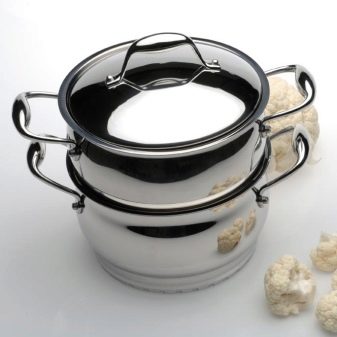
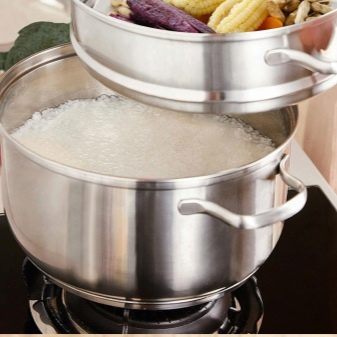
- Milk cooker. This type of saucepan is used exclusively for boiling milk. Usually this is a very small square or elongated pan made of stainless steel or aluminum. These pots are equipped with only one extended or "lowered" handle for easy pouring of milk into other containers.

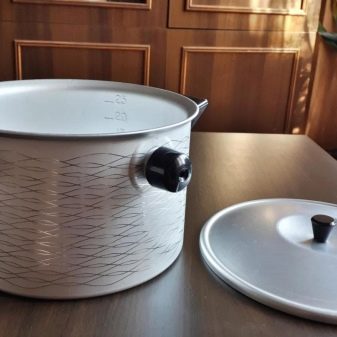
- Deep fryer. A type of electronic casserole often used in restaurants and cafes for quick cooking potatoes and vegetables. The principle of operation of such a pan is that food is fried in heated oil or fat. Most often, french fries are prepared in this way. The peculiarity of such food is the high content of oil.

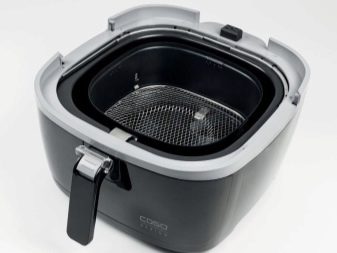
- An ordinary saucepan. The most common option for preparing a variety of foods. These pots have two handles, a glass or metal lid. For the manufacture of such pots, a variety of materials can be used, which will be discussed below.
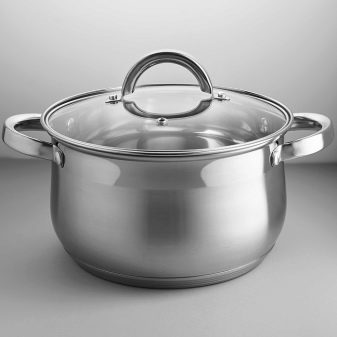
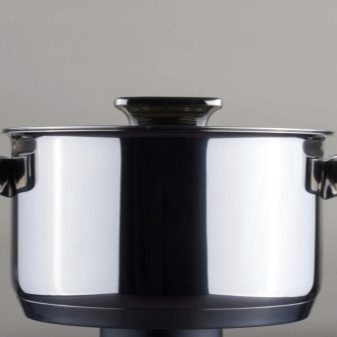
Materials (edit)
Today, there are several types of pots, depending on the material of their manufacture, the presence and type of coating, as well as the scope of use.
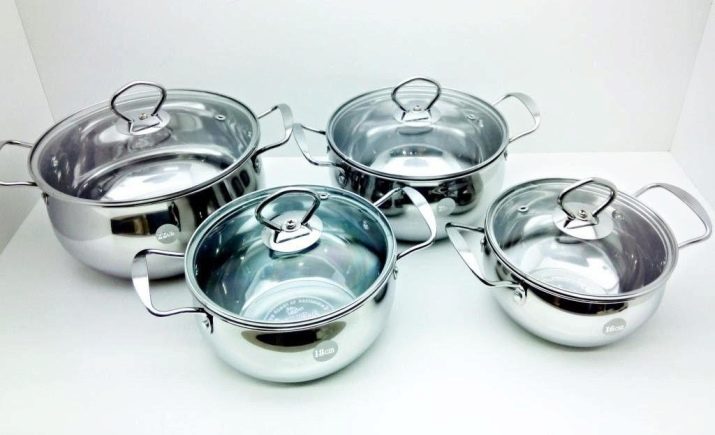
Enameled
It is considered a common option among housewives who prefer not only tasty, but also the most healthy food. In addition to technical qualities, enamel pots are often made in an original and beautiful design, which captivates many housewives.
Due to its thin coating, this saucepan is very light, heats up quickly, but is strong enough to withstand high temperatures for a significant amount of time. It is also preferable to store soups, cereals and other food in these pots, since the enamel performs a protective function and does not allow metal salts to oxidize and spoil food.
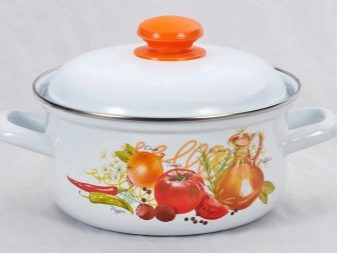
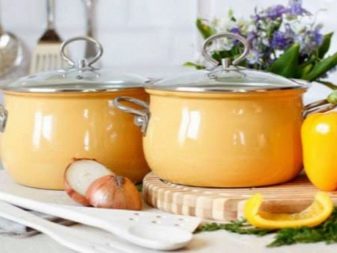
But enamel has never been distinguished by high strength characteristics, and therefore such a saucepan should be treated with caution - no falls, no use of metal shovels or knives. All this removes the enamel layer, which is then impossible to restore. The same applies to the use of aggressive detergents and cleaning agents and acidic solutions.
Such pots are characterized by the appearance of "gaps" (places of complete thinning of the enamel layer), after which it will be harmful to use such dishes. Enamel pots are ideal for cooking soups, side dishes and compotes, but for food that requires prolonged heat treatment (such as jam or syrups) is not suitable.
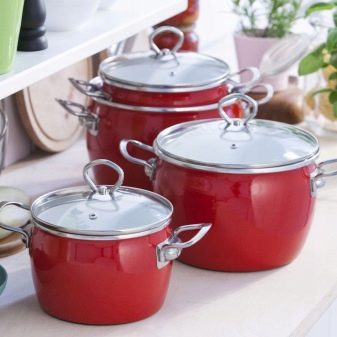

Today there are two ways to cover pots with enamel - by spraying and dipping. The fact is that models with spraying serve much less, and the protective layer of enamel on them very quickly becomes thinner. To independently determine the method of applying the enamel, it is enough to inspect the outside of the pan and find the attachment points for the handles.
Gaps in this place indicate that the enamel was sprayed on. Pay attention to the color of the enamel inside the pot. If on the outside it can be completely different, then only strictly defined neutral colors are allowed inside: black, white, cream, pale blue or blue. The fact is that enamel of any other shade is toxic and will cause irreparable harm to your health.
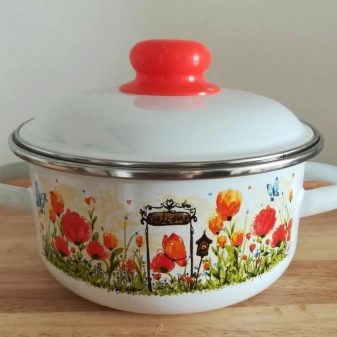
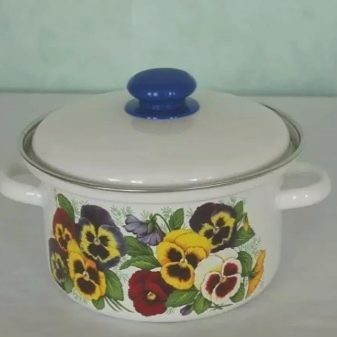
Examine the pan carefully - this way you can notice chips, cracks, and also roughly determine the thickness of the enamel layer.
Aluminum
A common variant of pots that they prefer to use in eateries, canteens, as well as places for cooking for many people. Any metal cookware, including aluminum, heats up remarkably. In addition, it is lightweight and inexpensive. But from frequent heating, aluminum containers are deformed, change shape, and also darken.
Besides, aluminum is not indifferent to alkalis and acids with which it can react. Because of this, the taste of the food itself changes, and heavy metals accumulate in the human body, which, over time, can cause serious illnesses.


Aluminum pots are most often used for making pasta, dumplings, boiling eggs, boiling milk. It is not recommended to use them for preparing diet food, multi-stage meals, as well as all foods with high acidity. When choosing an aluminum pan, you should pay close attention to only two things: the thickness of the walls and bottom, as well as its evenness.
The bottom should be at least 3 millimeters thick, and the walls at least 1.5-2 millimeters thick. You can also choose options with a good and tight-fitting lid and screwed on rather than welded handles.

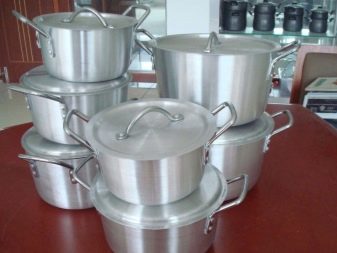
Cast iron
Considered one of the least popular options among modern housewives, it is valued for its durability and ease of grooming. Almost all housewives consider cast iron to be the most durable material for creating kitchen utensils. In addition, he is not afraid of any scratches or damage by metal objects. The individual advantage of cast iron pots is natural non-stick coating, which is formed after the impregnation of cast iron with oil. Moreover, cast iron cookware cools very slowly, and therefore can keep food warm for a long time.
However, cast iron kitchen utensils are very heavy, making them impossible to wash in dishwashers. In addition, cast iron has poor thermal conductivity, so it heats up for a very long time. Despite their strength, cast iron cookware is characterized by rust, which appears from water or long-term storage of vegetables.
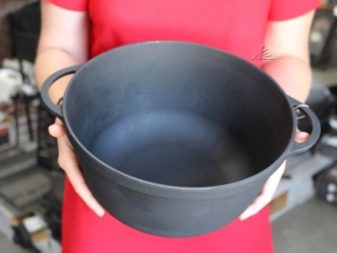

The cast iron pan is excellent for stewing, boiling and frying food, and is also suitable for grilling. In addition, cast iron trays are advised to be used when baking food in the oven.
High-quality cast iron is fairly easy to distinguish from low-quality cast iron.... To do this, it is enough to pay attention to the color and porosity of the pan. If in front of you is a smooth and light cast iron pan of a light shade, be sure that it will not last long. The richer the black color of the pot and the heavier it is, the better. The highest quality models of cast iron pots will weigh at least 3.5 kg with a volume of 3 liters.
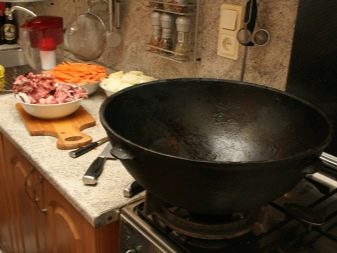
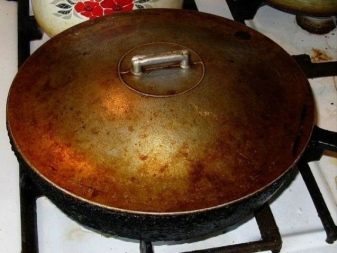
Teflon coated
A popular option for preparing vegetable dishes using a lot of spices and a minimum amount of oil. Such dishes heats up extremely quickly, while practically no oil is required to heat and fry food - the surface ensures perfect sliding of food along the bottom of the pan and prevents it from burning.
Typically, the Teflon coating will become thinner or damaged very quickly, making the pot unusable. After the Teflon coating is thinned, all food will gradually become saturated with carcinogenic gases that lead to the development of cardiovascular diseases.
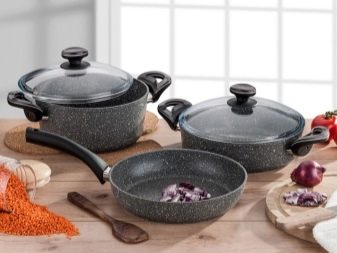
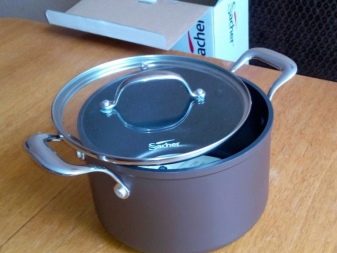
Pots with such a coating, at best, will last you no more than a year, after which the dishes will have to be changed. Most often, Teflon-coated pots are used for preparing healthy food. Teflon allows vegetables to cook well without letting them burn or lose their rich flavor. When choosing such devices, first of all, you should pay attention to the multilayer coating - the thicker it is, the longer the dishes will serve you. As a rule, the number of layers is indicated on the packaging.
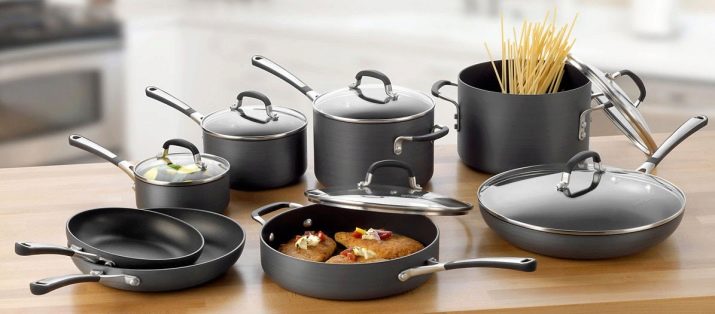
Ceramic
Another option for kitchen utensils. It does not enter into any reactions with oxygen or food when its walls become thinner. It keeps the temperature perfectly, in addition, it tolerates cold, so that it can be safely stored in refrigerated chambers. Frying in these pans does not burn food, although it does not have a non-stick layer.
But such pots weigh quite a lot, and are also unlikely to withstand falling onto tiles or tiles. There are often scratches on ceramics, which can make it difficult to cook food in them in the future. In addition to the fact that ceramic dishes are much more expensive than all other options, you will need a flame diffuser to use ceramic pots on gas stoves.
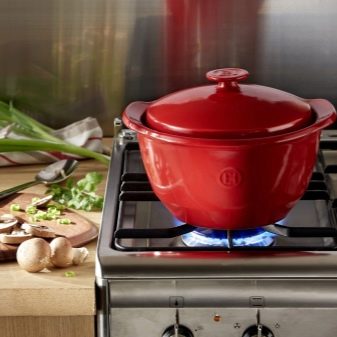

Housewives often use ceramic dishes for stewing meat, vegetables and cooking roasts. In addition, the ceramic casserole can withstand oven baking without any problems.
Avoid temperature extremes when using ceramic pots. So, it is better not to put heated ceramics in the freezer, and the cold ceramic saucepan that you just brought from the balcony should be allowed to stand a little at room temperature.
The fact is that ceramic cracks and bursts due to temperature changes. Also, the formation of chips is possible if all the water as a result of cooking from the container boils away from the container, and you do not add it yet. As for the choice of a ceramic pan, here it is worth paying attention only to the weight and thickness of the model. A high-quality ceramic pot should have a wall thickness at least 4 millimeters, and weigh at least 2 kg with a three-liter volume.
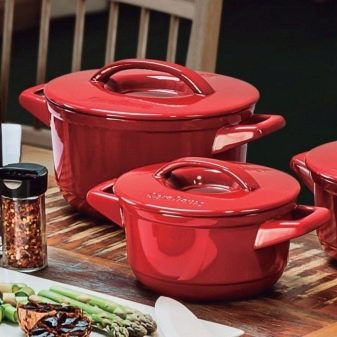
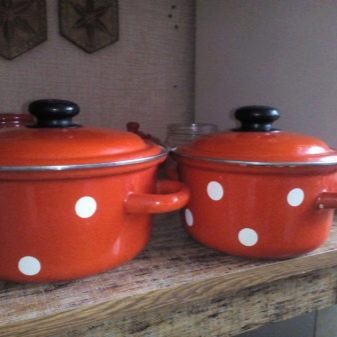
Glass
Glass pans differ from other pots in a variety of designs, as well as in a pleasant appearance. Glassware is inexpensive and beautiful, after cooking it, without hesitation, you can immediately serve it to the table, as it looks harmoniously with all appliances and dishes. Glassware does not rust, food does not burn or spoil in it.
Glass is absolutely safe and does not emit any harmful substances during heat treatment. The glass is easy to clean thanks to its smooth coating and is also dishwasher safe. Glass is resistant to temperatures, retains heat for a long time and does not deteriorate from storage in the cold.
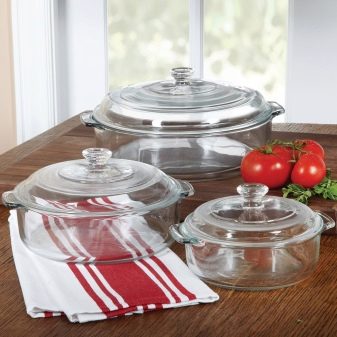

But for such a pan, you also need a fire divider or a partition (like in ovens). It is poorly resistant to drops and pressure; mini-scratches from cutlery and even food remain on the glass. Also, glass does not tolerate temperature changes and can simply crack. Glass pans ideal for making soups, side dishes and decoctions, cereals.
However, it is best not to use this material for frying and stewing. The glass darkens and becomes fragile from prolonged temperature exposure. A characteristic feature of low-quality glassware is the presence of multiple air bubbles, which in the future, if the pan is used improperly, can lead to cracks and chips. Also, make sure that the glass is transparent and slightly bluish - this color indicates quality and strength.

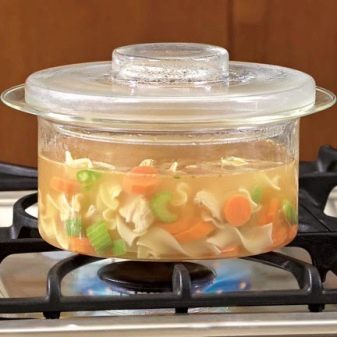
Stainless steel
A popular cookware option on the market today, found in every hardware store. It is stainless steel dishes that professional chefs prefer to use in the preparation of their kitchen masterpieces. Stainless steel has unique strength characteristics - it is shock-resistant, is not afraid of scratches or falls, it can serve for 5 or more years. Also, these dishes evenly distribute heat throughout the entire body. It is very easy to clean, as it tolerates aggressive products.
The disadvantages of stainless steel dishes are significant cost, low thermal conductivity. In addition, streaks form on stainless steel over time and cannot be removed. Stainless steel darkens and loses its luster over time.


Such utensils are suitable for any method of cooking, but they work best in stewing and boiling vegetables, meat and cereals. When choosing pots made of stainless steel, you should pay attention to the following parameters indicated on the bottom of the cookware.
- Usually the following numbers are indicated there: 18/10, 08/13, 12/13... The first one speaks about the proportion of chromium in the alloy, the second - about the nickel content. As a rule, the higher the values of the first digit, the better the purchased dishes will be. The best ratio is 18/10 - I am medical steel.
- Also pay attention to the thickness of the walls and bottom. The walls should be no thinner than 0.5 mm, and the bottom should be no less than 3 mm. Keep in mind that the higher these values are, the better the food will warm up and the more evenly all the heat and heat will be distributed over the dishes. The ideal option for preparing healthy food is to purchase a double or triple walled stainless steel casserole dish.
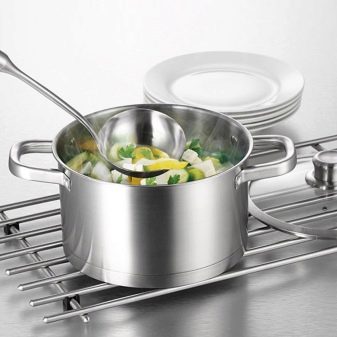
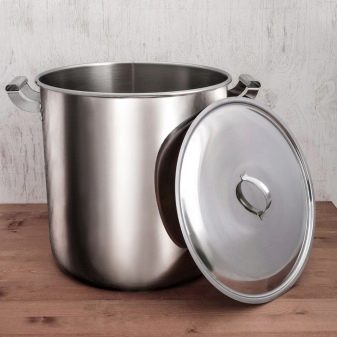
Copper
Also one of the options for professional use. She has an amazing thermal conductivity, which allows you to very quickly prepare any dish: from thorough frying to delicate temperature processing of food without the risk of burning. In addition, copper is actually safe for health, since it does not emit any harmful substances during heating.
It is the hammered models of copper pots that are especially valuable. It is believed that this increases the life of the pan by several times.
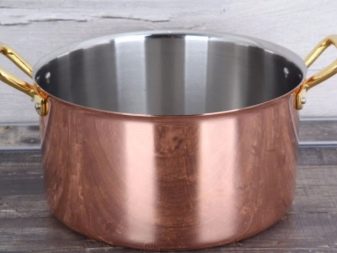
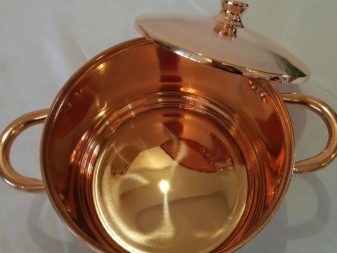
Copper cookware is extremely heavy, which can cause problems during the washing process. It costs significantly more than other metal, glass and even some ceramic models. In addition to this, the copper itself also needs constant maintenance - without regular rubbing, it will lose its pleasant appearance, and it will also become rough. In addition, all scratches and dents are perfectly visible on copper, since it belongs to soft metals.

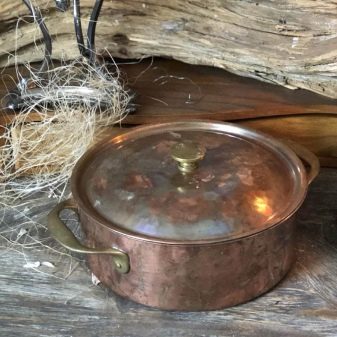
Copper cookware is suitable for any use - from boiling to stewing and frying. But best of all, she copes with plant foods thanks to the technology of gentle fire. According to reviews, when choosing copper dishes, you must first of all pay attention to weight.
Copper pots should weigh much more than stainless ones with the same volume.
Dimensions (edit)
Depending on the purpose of the dishes, the hostesses choose pots with a certain volume and size.
- Universal models... As a rule, these are cast iron, Teflon or aluminum pots with a volume of 3 liters. These parameters are quite enough for making soups, compotes and side dishes for a large family.
- Models for a large family. The volume of such pots is calculated at the rate of 1 liter per family member. Thus, a family of 4 relies on the purchase of a 4-liter saucepan (when it comes to cereals, jams, soups and drinks). For housewives who prefer to cook food for several days in advance, the pots should be larger - up to 10 liters.
- Small models for vegetables and eggs, side dishes. These are usually small metal or ceramic pots with a volume of 1 to 2 liters. These pots do not need to be oversized as they are used to prepare appetizers rather than main courses.
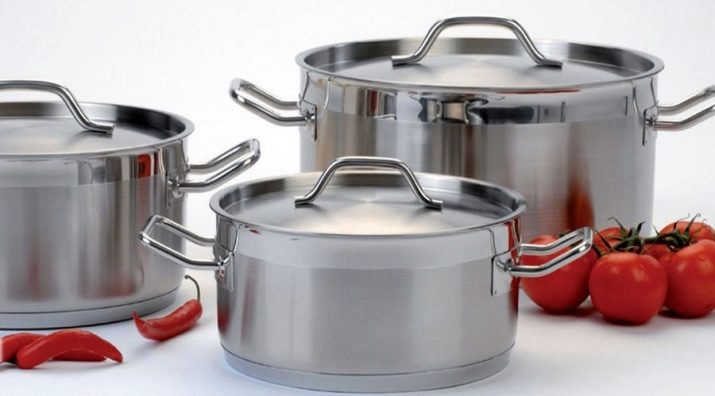
When choosing the size of the pan, one of the important parameters is also the diameter. For example, for dishes with a volume of up to 2 liters, the ideal diameter should be no more than 18-20 centimeters.
For medium pots - no more than 25 centimeters. With special attention it is worth choosing pots, if you are going to use them in ovens, steamers or ovens - make sure that the size of the model fits into the cooking area. It is best to get several pots of different sizes at once, but from different materials.
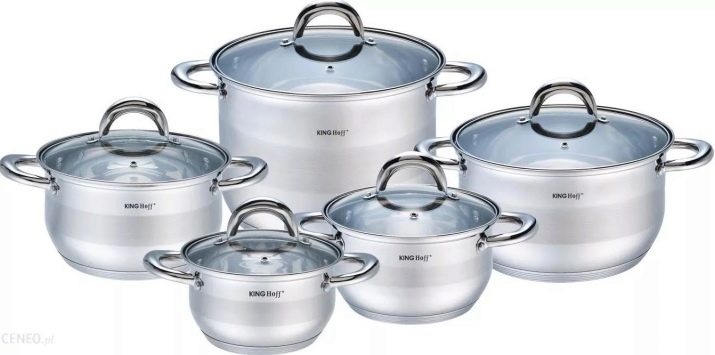
As for the shape of the pots, cylindrical pots are usually used for making soups, compotes, preserves and cereals. If we are talking about specific products - eggs, milk, some vegetables, then elongated pots are more suitable.
Design options
Unfortunately, due to the nature of some materials, work on the design of the pots is limited. Besides, professional chefs prefer high-quality rather than beautiful dishes. There are round, square, oval and semicircular pots.Each of these options are used to prepare specific foods.
The colored design of the cookware is possible only for enamelled and aluminum models, as well as for stainless steel pots. Especially popular recently are Provence-style enamel pots depicting flowers and plants. As for the metal options, here manufacturers prefer a single-color painting of the outer walls of the pan.
The most popular shades are red, blue, white and green. Glass pans can also boast a variety of colors, however the designs must be applied to clear glass.
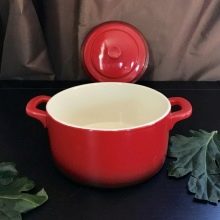

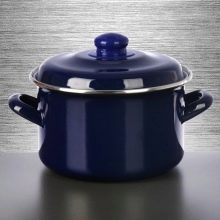
Recently, pots with removable handles have been increasingly sold. Equipping pot lids with temperature sensors is also popular. Pots with lids for draining water have become especially popular, through the holes in which steam can also pass freely.
Selection rules
Before buying any pot, you should carefully examine it for defects. Regardless of what material the models are made of, you should choose a saucepan with thicker walls and a bottom. This is the key to a long service life of the dishes. Also pay attention to the number of layers of non-stick coating. Take a look at the handles of the pan - for high-quality and durable models, they should be screwed on, not welded.
Be sure to check the model for chips, cracks or bubbles (in glass models), also check the evenness of the coating, the bottom, and the presence of scuffs. Different pots are suitable for different types of food. For cooking vegetables, glass and ceramic pots are more suitable, and metal models are suitable for cooking or frying meat. Don't forget to buy at least one small stainless steel saucepan for making cereals and sauces.
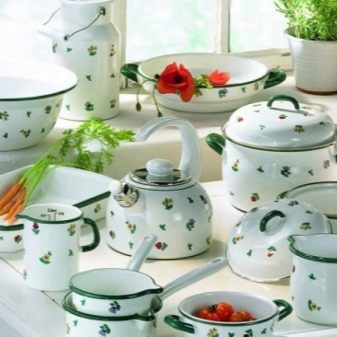
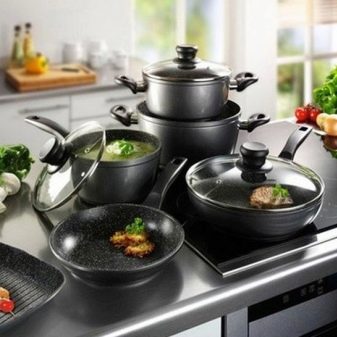
Operating tips
Every material from which pots are made needs to be cared for. If the same stainless steel is not afraid of sharp and heavy objects, then copper dishes can be severely damaged by them. Also, do not forget about regular preventive examination and cleaning of pots, so you can identify any problem at an early stage, and also extend the life of the product.
Regardless of the material of manufacture and coating of the dishes do not get carried away with the use of aggressive detergents to clean it.
When cooking, it is better to use wooden or polymer kitchen utensils - they are gentle on the dishes, preserve enamel and other coatings.
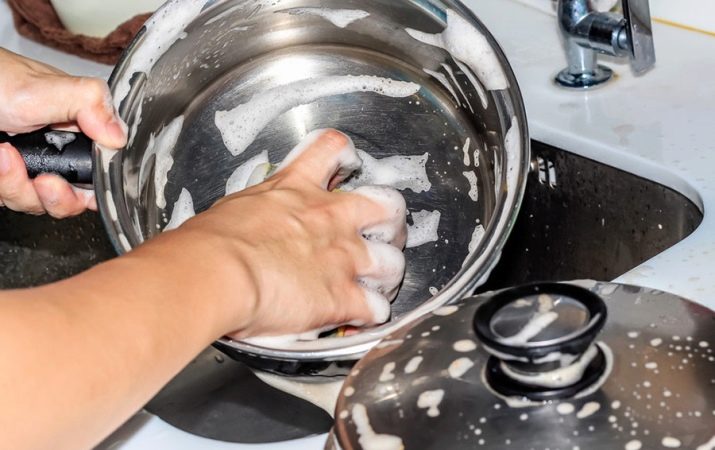
For information on how to choose the right pan, see the next video.








